Fearless makers are conquering ever more fields of engineering and science, finding out that curiosity and common sense is all it takes to tackle any DIY project. Great things can be accomplished, and nothing is rocket science. Except for rocket science of course, and we’re not afraid of that either. Soldering, welding, 3D printing, and the fine art of laminating composites are skills that cannot be unlearned once mastered. Unfortunately, neither can the long-term damage caused by fumes, toxic gasses and heavy metals. Take a moment, read the material safety datasheets, and incorporate the following, simple practices and gears into your projects.
Simple, Yet Effective
For tackling vapors, fumes, and flying bits, there are a few simple pieces of safety equipment that no maker should be without. This is the bare minimum when it comes to the mentioned hazards.
Respiratory Mask

A respiratory mask protects your lungs from fine dust and fumes. Simple, mechanical filters made from non-woven fabrics are ideal sanding wood or drywall. There are dedicated painting masks and multi-purpose respirators, typically with layers of active carbon filter material, that also pull out some volatiles. Ideally, you go for a NIOSH approved respirator, which are classified by their oil resistance (N = nope, R = resistant, P = proof) and by the percentage of airborne particles they are capable of extracting (95 = 95%, 99 = 99%, 100 = 99.98 %). A NIOSH P100 respirator is oil proof and removes 99.98% of particulates if worn right. Yet, be aware that they’re just filters. Some volatiles will still pass right through them.
Gloves
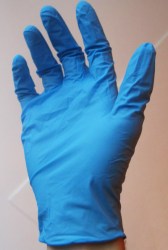
Even if you’re not afraid of getting your hands dirty in the workshop, consider wearing adequate gloves when working with substances that contain solvents, heavy metals or volatile organic compounds. Certain toxic volatiles have no problem entering your bloodstream through your skin, and thin protection gloves stop them reliably.
For fine work with resins or other chemicals, or for cleaning SLA 3D prints, go for nitrile gloves, as shown to the right. Nitrile gloves can also protect from incidental contact with stronger solvents like dichloromethane, but for extended contact with aggressive chemicals, consult a glove selection guide like this one or this one.
Gloves also prevent fine dusts, especially from carbon and glass fiber compounds, from causing skin irritations while sanding of milling. A pair of tough textile gloves will do here. Nevertheless, lathes and heavier drill presses yield a higher risk of injury when operated with loose gloves than without. It’s a compromise.
Safety Goggles
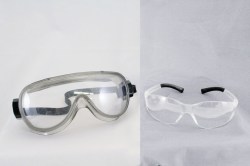
There’s an acute danger of putting your eyes out when working with live lasers without filter glasses — or while welding without a welding mask. Nobody would do this, right? Also, grinding wheels, angle grinders, and CNC machines will sporadically send dangerous projectiles their way. Besides that, long-term exposure to fine dusts, fumes and gasses can irritate your eyes and cause inflammations. They also provide easy access to your bloodstream, which is less romantic than it sounds within a cloud of toxic vapors. Just like everything else, safety goggles are standardized, but best maker-practice is keeping a pair of closed goggles and a pair of comfortable open ones. The former helps you out when dealing with strong chemicals (and shattering grinding wheels), and the latter increases the chance that you’re wearing at least something.
The Open Window
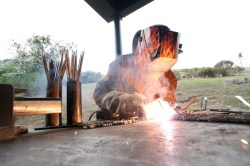
Be it while laser cutting, soldering, 3D printing or when working with organic solvents, make sure it’s happening in a well-ventilated area. The simplest and most effective way to reduce the parts per million (ppm) concentration of fumes and vapors is still an open window.
Taking your project outdoors can be even better. Professional work environments feature air cleaning systems and industrial grade protective gear, but workshops set up in poorly ventilated basements, garages or bunkers quickly saturate with toxic fumes and gasses. For the hobbyist, some activities are better done outside, where fumes and vapors dilute quickly.
Our Favorite Fumes
Some of our favorite activities come with hazards we should be aware of. The smell of burnt plastic and molten solder may ignite your creative genius, but the toxicity of these fumes shouldn’t be underestimated either. There are a few simple measurements you can take to minimize your exposure to hazardous fumes, dusts and vapors when working with your favorite tools.
Laser Cutting
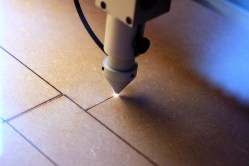
Vent. Professional laser cutters feature external ventilation systems and active carbon filters, cheap ones often don’t have a ventilation exhaust. Retrofitting an air cleaning system to the latter is affordable and will pay itself off every second you’re not inhaling plastic fumes.
Despite ventilation, there are materials you don’t want to place inside a laser cutter. Among them are ABS (releases hydrocyanic acid), Polycarbonate (releases benzene), and PVC (releases Lucifer from hell hydrochloric acid). Some of these fumes are also hazardous to your laser optics, effectively limiting the harm that can be done here. Avoid unknown plastics or find out what they are, research new materials, and if you’re laser cutting sheet metal, head down to the welding section of this post.
3D Printing
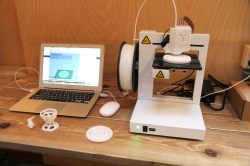
Desktop? On the one hand, if you’re not using your 3D printer too often, and it probably doesn’t earn its footprint on your desk, on the other hand, if you use it every day, you will certainly want to install the noisy thing far away from your workplace. PLA and PETG are often recommended as a less emissive and practically harmless alternative to ABS and Polycarbonate. But unless you want to stick to natural PLA, you’ll be sitting in a cloud of ultrafine particles and gasses emitted while either the print material itself, additives or colorants decompose during printing. ABS emits hydrocyanic acid and styrene fumes when heated, PC emits benzene, and some PETGs and Nylons contain additives with evenly potentially hazardous decomposition products. Don’t worry – there’s virtually no acute danger that these fumes will fell you instantly – but with continuous exposure in a desktop environment, long-term effects can be at least expected.
If used right, SLA printers can be less emissive than FDM printers. Yet it all depends on the resin. Most stock and third-party resins for 3D printing use are just fine, but on the hunt for photopolymers, look for the zero VOC kinds (less than 5 g/l volatile organic compounds). In case you’re wondering, some (not all) photopolymers indeed contain homeopathic doses of the toxic heavy metal antimony in their photoinitiator. As a trace amount of a trace amount that isn’t released during normal use, it’s certainly the least of your problems. Uncured resins are irritating to the skin, so nitrile gloves for the cleanup and post-curing are the way to go here.
Soldering
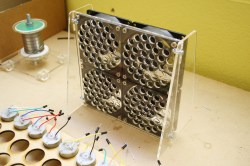
Open a window and get a solder fume extractor. Regular solder contains lead, and heating it up produces lead oxide fumes, which yields both short term and long term effects on your health. If you find yourself soldering a lot, a solder fume extractor will pays for itself and save you some headache, one of the common symptoms of lead oxide poisoning. Too costly? It’s just a bunch of fans and an active carbon filter pad, build your own!
Female hackers should mind that increased lead exposure is also linked to infertility, birth defects, and other reproductive harm. Consider lead-free solder as an alternative. Young hackers, and those who guide them, should be aware that even small amounts of lead can affect brain development. It’s better to complete the brains of your first robot lead-free. If you’ve ever had the pleasure of seeing experienced solder-instructors like Mitch Altman at work, you’ll notice that he takes special care to make sure all used materials are lead-free.
You probably prefer using solder wire with flux cores. In presence of lead, rosin-based flux is certainly the least of your problems, but it may cause irritations and yield long-term problems including asthma and dermatitis. Need a snack while you hack? Wash your hands before to avoid ingestion of lead and flux.
Brazing
Avoid cadmium. Most of what’s true for soldering is also true for brazing. Yet, some silver solder alloys additionally contain cadmium. Cadmium is a toxic heavy metal that can actually knock a naive user out, so opt for zinc or nickel alloys instead.
Welding And Plasma Cutting

Ideally done outside. Electrowelders, TIG welding units, and plasma-torches have become cheap, and it’s easier to learn than most think. Welding is also an activity that emits plenty of toxic fumes and gasses into midair. Inhaling zinc oxide and magnesium oxide fumes, which emanate from galvanized steel during welding, can cause an illness known as metal fume fever. A respirator helps, although besides toxic fumes, also gasses are emitted from the filler material, other welding consumables and impurities (e.g. paint) on the welded material. Long-term exposure to welding fumes is known to cause lung cancer and a number of other diseases like asthma and pneumonia. Needless to say that welding without a welding mask will affect your eyesight, but good ventilation is equally important. For the hobbyist, all this is ideally done outdoors.
Sanding And Milling
Wear a respirator. Other than gasses and vapors, particulates from sanding or subtractive machining can easily be brought under control by wearing a simple respiratory mask. Additional safety goggles protect your eyes from acute injury and irritating dusts, especially from materials like glass fibers (e.g. from FR4 PCBs), and carbon fiber compounds.
Volatile Substances
There’s nothing as satisfying as using the correct solvent or resin for a given application. If you’ve noticed that a few of them smell funny, that’s your clue to check the backside of the container and do some reading.
Acetone, Turpentine, Naphtha, “Brush Cleaner”
Open a window and wear gloves. Even if you ignore all safety instructions on the container, you’ll probably automatically open a window when working with turpentine or acetone. The latter isn’t considered carcinogenic (anymore), but skin contact with the strong solvent as well as inhalation of its vapors can cause irritations. Turpentine, on the other hand, also commonly used as a brush cleaner, is indeed considered toxic, and its fumes will typically cause a headache, reminding you to take action and get some fresh air. It’s worth mentioning that there are a number of turpentine-replacements, including naphtha-based brush cleaners, that can be carcinogenic as well.
Dichloromethane (DCM)
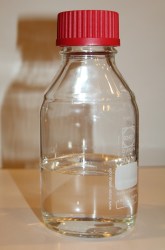
Avoid it if you can. Beyond the usual suspects, one of the more controversial solvents is dichloromethane. It’s highly volatile can even enter one’s bloodstream not only through vapor inhalation, but also through skin contact. In the EU, it’s banned as toxic and carcinogenic, despite the absence of useful replacements for applications like paint-strippers. It’s commonly used as such in the US and in other parts of the world, where it’s likely to be marked as toxic. It’s toxicity mostly affects workers who are exposed to the solvent unprotected and on a regular basis, rather than the hobbyist who uses it once.
However, it’s often suggested (e.g. here and here) to use dichloromethane to mix polycarbonate slurry as a means of improved build plate adhesion in desktop 3D printers, or to use dichloromethane to smooth prints from polycarbonate. If you plan to do this on a regular basis, maybe even in a desktop environment without further safety considerations like a self-contained breathing apparatus and chemical gloves, you might be facing a similar destiny as more than 14 bathtub refinishers, who the OSHA reports have died since 2000 from repeated dichloromethane exposure.
Polyester Resin
Use epoxy instead. Polyesters and other resins that contain volatile organic compounds (VOC), in particular styrene. If and how much styrene is actually carcinogenic is not entirely clear, but excessive exposure definitely leads to dizziness, with more acute risks when using heavy machinery or conducting vehicles afterward. Think twice if your project really requires polyester resin – epoxy may be more expensive, but it delivers a better mechanical performance and is far less costly in terms of your health.
Toxic Heavy Metals
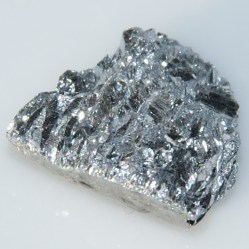
Be aware and take care. Toxic heavy metals can be found both in solder and brazing fumes (mostly lead and cadmium), welding fumes (arsenic, chromium), in some photopolymers for 3D (and 2D) printing (antimony), and of course, in mercury switches and antique thermometers. If absorbed by your body, toxic heavy metals have the tendency to accumulate over an entire lifetime. They typically bind to certain organs or vital systems, where they may concentrate to toxic levels over time, causing various diseases from cancer over nervous disorders to diabetes.
Their toxicity depends a lot on their dose and application, as their presence in solder, piping, food packing and dental fillings shows. Still, avoid naive, repetitive exposure. This can be as simple as washing your hands after soldering, or wearing respiratory protection when welding or during other activities that bring you in contact with fumes and dust that contain heavy metals.
Don’t Panic
If you made it so far, a bit of soldering won’t knock you out, a bit of 3D printing won’t harm, and a bit of laser cutting won’t hurt. That’s not what this post is about. We’re not made of glass! Yet, the maker movement is going places, and there’s a growing gray zone where occasional fun projects develop into production-scale undertakings, and where art projects become monumental life works. Repeated and intense exposure to some hazards is a very different game than a little tinkering once in a while, and it really doesn’t take much to prevent long-term consequences. I’m sure many of our readers have great advice to add to this, be it from professional experience with occupational safety standards, or their own implementations to tackling solder fumes. Let us know in the comments!















A slightly different fume extractor that I’ve made for soldering which (for me is important) is quiet. http://www.instructables.com/id/Super-cheap-efficient-and-quiet-smoke-extractor/ Probably easily adaptable for other purposes, such as laser cutting… Note that I added an inline (baby) oil bubbling chamber which trap most of the particles before the inline fuel filter. It just add some noise.
For DIY use I mean, I wouldn’t use such “no filter systems” for industrial processes.
Re: soldering fumes. All the information I’ve found, says that at normal electronic soldering temperatures (600-800F), lead or lead oxide fumes are not a significant risk. I’ve found one OSHA reference to lead oxide, but not to the type of soldering that would form it (plumbing soldering uses a torch and higher temperatures)
Wash your hands and don’t breathe the fumes. And don’t hold the solder in your mouth.
I figure if I hold the solder in my mouth long enough, I might mutate a third hand which would allow me to no longer need to hold the solder in my mouth. Still working out the details.
The article is completely innacurate in this regard.
Normal soldering temperatures don’t produce any lead oxide fumes or only in harmless quantities. In order for lead oxide to form lead has to be heated over 600 degrees Celsius (1112 F). Normal soldering is done at around 300 C, up to 400 C max so this has no chance to form.
There has been even a scientific study done on workers in PCB assembly hall that are constantly around molten solder and no elevated amounts of lead was detected in their bloodstream (this was before leadfree solder, etc.).
So there is no need to be afraid of leaded solder unless you eat it for dinner.
The switch to lead-free solder was done mainly for environmental reasons (lead accumulates in the environment over time, e.g. by leaching from landfills full of discarded electronics), not because of lead poisoning hazards during soldering.
The soldering fumes are mostly burning flux and any residues you may have on the tip of the iron (e.g. traces of molten/burned PVC insulation from wires!). Those are unpleasant and potentially toxic, so you may want ventilation (e.g. a small fan blowing them away from you). However, that applies regardless whether you are working with leaded or lead-free solder.
What I’ve heard is that it doesn’t even leach much from solder and PCBs etc, it was lead compounds in smashed TV tubes etc that was doing it.
And yet car batteries still make it to the landfills…
Car batteries have something like a 98% recycling rate. They are an incredibly small source of lead in landfills.
This is what I hate: one guy says this, another guy says that, a third guy says something completely different, and as a newbie to all this stuff I just don’t know who to believe! I do use leaded solder and I solder happily at 300C and I bought these masks that you wear on your face to protect myself from the fumes, but I would rather not use the masks, if not necessary, as they are in the way and unpleasant to wear.
I have no intention of playing with any other chemicals than solder, solder paste and flux, but it’d be nice if I could find one, single, trustworthy and complete explanation on what safety precautions I should take or what not to do.
theoretically under ideal conditions only very small amounts of lead oxides form under 280 degrees Celsius, however above that things start to change quickly with several different chains of oxidation, to be safe if you are soldering at 300C i would use a mask or extractor fan, truth be told i would use a proper extractor fan since masks rarely fit well in my opinion, thing is that 250C should be enough for any pure tin/lead solder, that said i would use a fan anyway, better safe than sorry and a computer fan with a small section of ducting out the window will do wonders.
thing is many talk about the solubility of the various oxides in fat or water, issue is some of the other oxides dissolve readily in acid, including stomach acid and can be equally toxic, while forming at a lower temperature than the oxides most people worry about. (lead dioxide is known to form in temperatures as low as 280C)
It’s stupid to believe anyone. Belief is the death of possibility, therefore death of curiosity, therefore death of learning.
Collect the data, consider all the possibilities of their arguments and form your own conclusions.
Consider the “it’s bad” guys are taking the safe bet and might just be fear mongering.
Consider the “it’s safe” guys are forming that conclusion based on a theory assembled from their very limited knowledge base.
Anything regarding health is going to be junk science for the most part due to how they have to collect data.
That’s just a stupid reply. “Collect the data” — What data? There is no data! People are just spouting opinions and claims, there is nothing quantifiable to collect in the first place and nothing useful to base an informed opinion on.
On that basis, if you encounter too great a hazard and then die, your sample size is one and you don’t get to do any analysis on it anyway. That’s not how science works, at least in our universe.
+1 The heavy metals are potentially a problem with welding, plasma cutting, and grinding without liquid coolants. These elements get dangerous when they form compounds that are soluble with in fats and water.
Cast iron dust will definitely cause lung disease, whereas all these carcinogen warnings are based on an indirect indicator effect on bacteria.
(Brazing also gets hot enough. But really, to do great brazing or silver solder, use a hydrogen oven and you won’t need flux.)
Are you sure about the hydrogen? I would consider this very dangerous – e.g. having extremely flammable and explosive hydrogen in the vicinity of glowing heating coils. But I know about nitrogen filled ovens to prevent oxidation and reduce the necessity of flux.
Yea. You don’t’ circulate the hydrogen. The oven is fairly well sealed and the hydrogen concentration is nearly 100%. Without the oxygen it isn’t flammable. The hydrogen reduces all the oxides when temperature get up. To use it right you need to calculate the amount of silver solder or brazing needed and clip small lengths and place them where they will wick into the voids. The result is a bright and shiny object with no flux to clean. Let me check the Interwebs….. http://www.lucasmilhaupt.com/en-US/about/blog/2013/12/furnace-atmosphere
A quick search shows mostly services and expensive ovens. I have some instrumentation/vacuum construction books from the 1980’s and they have toaster oven sized (maybe a little bigger) dry hydrogen ovens. This seems like an area ripe for a DIY / hacker solutions.
Another useful tip: Never place any food items at your soldering bench. It’s common sense to many people, but not everyone. At a company I worked for a long while back, it was not uncommon to see the technicians with a soldering iron in one hand, and a bag of potato chips in the other. It’s a good path for ingesting lead.
Yes and I bet they are still at it and likely no worse for the wear. The amount of lead you ingest like this is very tiny and the risk of it accumulating sufficiently to poison you over time is low.
Of course, that doesn’t mean that this is a sound practice – why to risk the lead poisoning for own stupidity and there could have been much worse stuff on that desk than leaded solder before. However, I guess it goes in the same category as some people not washing hands after using a toilet …
Anecdotal evidence to the contrary, a guy at my college actually had lead poisoning issues requiring treatment from exactly this. I don’t remember all the details, but something about the salt from the chips reacting with the lead to make it more bioavailable — of course, it could’ve just been greasy finger picking up a lot of dust, too. Either way, I make a point to wash my hands after soldering now!
Also something to whatch out are pcb splinters and -sawingdust.
I found out about polycarbonate the hard way. Art project where I was the coder; the art students had laser cut the PC pieces, but our attempt to epoxy them together was ugly as hell. Professor told us to redo it.
I had my soldering iron and wood burning tips, because I was making the brains of the device and kept all the tools in one bag, students suggested we drill holes. The available drills shattered one piece and marred another. So we decide to mult our connection holes. Plenty of ventilation in that building, we even set up extra fans and turned on the giant exhaust blowers (maybe for when the kiln was in use, idk what it was for).
For days I could barely speak. Weeks before my voice came back completely, and months before I could get the taste of burnt PC out of my mouth. All because I believed the art students when they said “sure, we can design, laser cut, and put the box together.” I assumed that meant kerfed curved edges, dove tail joins, or that they knew how to epoxy it; what they meant was “sure we can design and have it laser cut, but you’ll have to tell us how to assemble it. We aren’t material engineers”.
Welding outside does however bring up the problem of too much ventilation… anything that uses shielding gas is very sensitive to wind, which simply blows it away, exposing your weld to air and causing your welds to look like swiss cheese.
An actual danger related to welding is zinc-coated steel, as welding it releases zinc oxide, which is an inhalation hazard.
Leaded Solder:
Easy to use due to lower melting temperature
Also easy to recognize bad solder joints as good ones will be shiny.
No lead or extremely little lead in the smoke as lead just doesn’t vaporize that easily.
Smoke is burning resin, resin is mainly pine sap. It’s not good for you to enhale but it isn’t that much different from a bonfire.
Product lasts a really long time. Antique radios as much as 100 years old exist today that still function.
Improper disposal means lead will leach into water
Unleaded Solder:
Hard to use due to higher melting temperature. You will need a hotter soldering iron and quite possibly will burn components.
Resin made from nasty chemicals that make nastier fumes when burnt
High tin content means product does not last. You will not be showing your grandchildren what you built.
Small surface mount connections will stop conducting
Tin whiskers will cause shorts.
Hard to recognize bad solder joints as even good ones look dull and grey.
Yes. I would avoid eating something like chips in the lab, but otherwise avoid leadfree solder.
I could make up shit too but I don’t need to as I have no agenda. Leaded solder corrodes too and I’ve seen many old products where the solder joints were destroyed by oxidation. Leaded solder tend to have worse kinds of flux (resins are one type but there are others) health wise as there are better controls, better research and harder regulations today. Lower melting temperature isn’t always a positive and for most parts the higher temperature of lead free solder isn’t a problem (as they have been designed for production soldering at higher temperatures) but there are alternatives without lead – I still use lead solder for those cases though it isn’t without problems (it means I can’t use bismuth containing solder without precautions).
The idea that lead free solder doesn’t create shiny joints just indicates that you haven’t done your research, I personally use germanium/nickel doped solder which creates very nice joints (good flow, very shiny).
Does anyone else have a problem finding a dust mask which seals properly along the top edge? A gap always seems to form between the bridge of the nose and the cheek under my eyes. I do have a large nose but I’m no Cyrano.
Yeah, me too, breathe in and they’re farting against my lower eyelid, pull them down lower and they’re just sitting a quarter inch off my cheek. Some soft masks are sorta okay if I basically mash them down with googles, but haven’t found a rubber and filter one that works worth a damn.
I used to have similar issues when using the cheap disposable face (dust) masks (like the one in the photo in the article but also the cheaper ones as well). I found I couldn’t bend the nose enough to seal and have the elastic cord tight enough without something not sealing against my face.
My solution was to get a proper face mask that can take changeable filters which can cost more in the short term (the chemical filters are the expensive bit, dust filters less so) but I can happily wear the whole day with glasses on and can swap between filters. Mine is a “scott profile 2” which has a soft silicon ring to seal against the face and a strap that sits comfortably over the back/top of the head that allows easy removal.
Use a real respirator. Those dust masks are a joke, even the more fancy ones with the valve. They never seal properly and respirator filters have a larger surface area that makes it easier to breathe through. In the long run a real respirator will actually save you money because they last much longer than the disposable masks. I spend a lot of time wearing a respirator and my favorite is the 3M 6300. Very comfortable and lightweight with a good seal. I was previously using an AO Safety R5700 model that was heavier and very uncomfortable. I like the 3M 2291 P100 particulate filters, very lightweight and low resistance to air flow. Respirators come in different sizes make sure to get the right size for comfort and a proper seal. .
I get the same problem with a respirator. Open my mouth slightly and the jaw movement causes a seal. Now to remember to keep your mouth open like a bird on a hot day :) Might work for the dust mask but that’s the main reason for the wire at its top.
Maybe try surgical masks. Still not a respirator but they are comfortable, light, easy to put on even when your goggles are on and more likely to conform to your contours. Some pharmacies sell them.
A guy I work with always welds without a mask. He just stares right in to the joint as he makes it. He’s 50 years older than me so maybe it’s a generational thing.
Electrowelders? Ugh.. Whatever.
Anyway arc welding, either mig or tig is usually done indoors. MAG or Stick you might want to do outdoors or indoors with very good ventilation. Doing MIG and TIG outdoors leaves you at the mercy of the wind which is a very bad thing. Thats why outdoor steel construction is done with wire feed flux core (MAG) or Stick, no gasses to get blown away. Flux smoke is awful….
MIG and TIG produce very, very little in the way of fumes, especially if you clean the metal of all oils before hand. Yes, there can be a little bit of hexavalent chromium when working with stainless but a hobbies will never see enough exposure to it.
As for resins, dont let uncured stuff get on you. And virtually all of these resins are epoxies. The problem with the resins in not the carcinogenic factor, it is the sudden sensitization that can happen from just simple exposure to the stuff. I had a friend who used resins for casting and suddenly became allergic to it virtually overnight, she would develop rashes just from being near the stuff when it was being mixed. We talked to the distributor of the resin and they said this is actually a pretty common occurrence.
MAG is not flux core wire, it is “Metal Active Gas” mostly containing carbon dioxide and sometimes partially Argon. But I don’t know the advantages of of MIG vs. MAG.
MAG uses either “pure” (technical grade…) CO2 or a mix with a high percentage of it…
MIG uses something inert, usually straight Argon or welding mix, which are both several times more expensive then CO2. Also the weld behaves differently.
Most people seem to refer to flux core wire as MAG because even solid wires often use CO2, either straight CO2 or 75/25 Ar/CO2. About the only thing mig that uses straight argon is aluminum.
Straight CO2 has stronger cleaning action, it is not very popular in the US but Japan uses it a lot. There machines are designed specifically for CO2 since it has a different voltage drop and curve vs Ar/CO2 which is the most popular steel gas here in the US. It also has a lot more spatter than Ar/CO2.
You should also point out that with 3D printing, or any process using high levels of heat, that the decomposition or partial combustion byproducts can be complex and unpredictable therefore just referring to the MSDS for a given material may not be adequate. If in doubt, i.e. always, use a fume extractor and have clean air flowing past you and toward the work area or device then to the exhaust vent. If you want proof that these machines are really cooking up all sorts of nasty stuff find a hard working 3D printer and scrape the heat effected gunk off it, then get it analysed by a spectroscopy equipped lab.
that might be quite a nice experiment, injection moulding can also subject polymers to thermal degradation, some of the “plugs” from clogged nozzles had some really interesting consistencies to them.
usually only a partial clog would form so no pressure would build up, the working pressure can range into the hundreds of bars, but every once in a while some small piece would get stuck in some internal crevice for longer than usual and become hard enough to actually clog the nozzle completely.
worst case one had to disassemble the entire auger to get it out, best case one could disengage the injection nozzle from the mould and manually force the plug by feeding material until you hear a very loud pop, if the machine designer did their job well you don’t have melted polymers all over your shop, any holes in the safety covers will be found by the spray.
1) i heard electronic solder flux was no longer made from refined tree sap resin
2) i did not read the details, but im pretty sure the lead oxide thing is for when you forget your iron on high and develops a black goo that has a different (room-filling) smell that almost reminds me of melting (fire-retardent?) plastic
3) if you suspect an oil has PolyChlorinated-Biphenyls call your relavent hazmat team and DO NOT TOUCH THE OIL OR ANYTHING THAT HAS BEEN TOUCHED BY IT, conventional cleaning will still leave significant traces that will evaporate and settle on EVERYTHING and remain in you and outside and can cause cancer and other effects for you and anyone living in the same planet for generations. even your human-waste will cause it to remain in your rivers, farmfields, dusts, public parks, and buildings, even the north pole(and south). it will be breathed and eaten due to you for a very long time. this substance needs to be destroyed completely. this destruction can NOT be done at home nor is legal to do at home. also, it will give you bleeding-rashes that last for months and will leave rash-scars. it may cause liver damage, reproductive harm, a syndrome SIMILLAR to AIDS (IDS ie no “Auto-“), retardation of your future offspring, motor control impairment, hormone disruption(including thyroid), skeletal and mental problems, anemia, stomach, behavioral alterations, hearing loss. basically everything you can think of PLUS cancer and even death.
this is one of the few substances that is as bad as atomic-fallout when it comes to breakdown. failure to burn PCB at a high enough temperature actually creates chemicals MORE-harmfull, and is why it would/should be illegal to intentionally try and destroy it without passing multiple tests.
at least atomic fallout has easily detectable radiation that can tell you if it is safe to eat (something) PS: it’s in all food due to oceans and atmosphere
Some is, some is not. I have a flux-stick and it is definitely tree rosin. Smells great when you use it.
… and some of us might have walked up to an actual tree and pulled a chunk of rosin off… (Wanted to make a liquid rosin for a special job)
PCB’s are not known to cause cancer in humans. Some old PCB’s in municipal transformers and geophones, and many other places where the dielectric properties and stability were useful, have higher than normal traces of dioxin, and it is pretty toxic. Though it doesn’t show up as a cause of death at anywhere near what the toxicity numbers predict.
ZOMG! PANIC! FLAIL! PANIC AND FLAIL!!!!!!!!!!!!
No mention of cyanoacrylates or toluene?
Don’t forget about uv burns when welding I got a nasty set of burns through a ripped top last year while trying Tig welding for the first time..
I would also suggest against spending an afternoon arc welding wearing just a pair of boxers, leather gloves and a leather apron even if it’s a 40c day.
The resulting sunburn is painful and everyone laughs at you when they can see the outline of what you are wearing in the result.
I would love to find an alternative to Dichloromethane for cleaning PLA gunked hotends when mistakes are made or repairs have to be done(I use nylon ‘cold pull’ when the machine is together, but it’s not an option and doesn’t get into threads and other places the stuff has leaked because things didn’t get tightened down right).
A day or two soak in half acetone, half DCM cleans everything up nicely, leaving only carbon(And I’m not going near the solvents that attack that!). Use mostly ABS as it’s much easier to clean up and work with. And the printer stays in a room with plenty of ventilation.
My instructor gave me a very simple technique for safely welding with galvanized steel: don’t do it.
There’s no reason why anyone should want to weld, braze, or solder two pieces of galvanized steel together unless you’re getting paid for it. If you have to attach them, you can use rivets, crimp, fold or even tape them together, but welding should be your absolute very last resort, hands down. If you must weld them, like if the situation is critical and you don’t have any other options, you need to take your angle grinder and grind off all of the coating around the area you’re going to weld. If you’re to that point, you’re probably a professional welder and know all of this stuff already, and you have all the appropriate PPE and OSHA certifications. Don’t weld random metals unless you know exactly what you’re welding.
That bit about lead in the air from soldering being a serious hazarz is fiction. The primary danger from soldering is the flux fumes, and lead free flux fumes are much worse than lead. As long as you wash your hands, lead is much safer than lead free.
As for working with resin. Regular dust mask are not enough.
During resin pouring get a good mask with ABEK filters. Change them regularly too as they fade. Having a P1 on top for general dust is fine too but breathing will be harder.
For resin and fiber work when cured. Protect your lungs with P2 or P3 filters. Living with a removed lung lobe or more is no fun. I know 2 examples, hobbyist both.
Moreover protect your skin. That dust itch big time. Even in summer cover your arms and legs, use gloves. Don’t think it is just a bad time to pass. These tiny fibers works like amiante fibers. They will no destroy themselves only your cells…
Also wash fresh resin on your skin (broken gloves for example) with white vinegar.
Acetone while efficient is a no go. It will help as a solvent letting the chemicals go in your blood. Allergy reaction is possible too but it could be worse…
I liked that you said that having proper ventilation is crucial to preventing the inhalation of fumes and dust. I would imagine that the inhalation of fume and dust while working on projects would be hazardous to your health. I would be sure to use proper ventilation to avoid inhaling hazardous material in order to protect and ensure proper health.